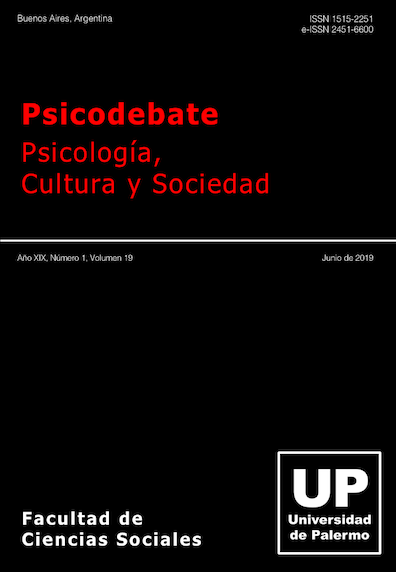Relational similarity as a defining feature of analogies: A questioning from the categorical approach
Abstract
The structure-mapping theory posits that the central component in establishing an analogy is to discover that two situations share a system of similar relations. Two experiments were performed to evaluate the hypothesis of the categorical approach that relational similarity does not constitute a necessary nor a sufficient condition for people to judge that two facts are analogous, and that the determinant factor is whether or not the compared facts belong to a common schema-governed category. In both experiments, 20 psychology students received a base fact and two target facts describing simple events, and they had to evaluate how analogous the base and each of the target facts were. In Experiment 1 both target facts included relations that were not similar to those included in the base fact. However, while in the first target fact the object to which the action described by the relation was applied made the whole fact became an exemplar of the schema-governed category applicable to the base, the object of the second target fact made it became an exemplar of an alternative schema-governed category. Experiment 2 has the same structure than the first one, with the only difference being that base and target relations were similar. In both experiments results showed that the first target fact was considered analogous to the base fact, but not the second one. This evidenced that relational similarity is not necessary (Experiment 1) nor sufficient (Experiment 2) to consider that two facts are analogous, and that, instead, the criterion employed by people to determine that two facts are or are not analogous is category membership. We discussed the implications of these results for the development of theoretical and computational models on analogical thinking.Downloads
References
Clement, C. A., & Gentner, D. (1991). Systematicity as a selection constraint in analogical mapping. Cognitive science, 15, 89-132. https://doi.org/10.1207/s15516709cog1501_3
de la Fuente, J., & Minervino, R. A. (2008). Pensamiento analógico. En M. Carretero & M. Asensio (Eds.), Psicología del pensamiento: Teoría y prácticas (pp. 247-268). Madrid: Alianza Editorial.
Falkenhainer, B. (1990). Analogical interpretation in context. En M. Piatelli Palmarini (Ed.), Proceedings of the 12th Annual Conference of the Cognitive Science Society (pp. 69-76). Hillsdale, NJ: Lawrence Erlbaum Associates.
Falkenhainer, B., Forbus, K. D., & Gentner, D. (1989). The structure-mapping engine: Algorithm and examples. Artificial Intelligence, 41, 1-63. https://doi.org/10.1016/0004-3702(89)90077-5
Forbus, K. D. & Gentner, D. (1989, julio). Structural evaluation of analogies: What counts. En Proceedings of the Eleventh Annual Conference of the Cognitive Science Society (Vol. 34, pp. 341-348). Hillsdale, NJ: Lawrence Erlbaum Associates.
Gentner, D. (1983). Structure-mapping: A theoretical framework for analogy. Cognitive Science, 7, 155-170. https://doi.org/10.1207/s15516709cog0702_3
Gentner, D. (1989). The mechanisms of analogical transfer. En S. Vosniadou & A. Ortony (Eds.), Similarity and Analogical Reasoning (pp. 199-241). Cambridge, UK: Cambridge University Press. https://doi.org/10.1017/CBO9780511529863.011
Gentner, D. (2003). Why we're so smart. En D. Gentner & S. Goldin-Meadow (Eds.), Language in mind: Advances in the study of language and thought (pp. 195-235). Cambridge, MA: MIT Press. https://doi.org/10.7551/mitpress/4117.003.0015
Gentner, D. & Kurtz, K. (2005). Relational categories. En W. K. Ahn, R. L. Goldstone, B. C. Love, A. B. Markman & P. W. Wolff (Eds.), Categorization inside and outside the lab (pp. 151-175). Washington, DC: APA. https://doi.org/10.1037/11156-009
Gentner, D. & Maravilla, F. (2018). Analogical reasoning. En. L. J. Ball & V. A. Thompson (Eds.) International Handbook of Thinking & Reasoning (pp. 186-203). Nueva York, NY: Psychology Press.
Gentner, D. & Markman, A. B. (1997). Structure mapping in analogy and similarity. American Psychologist, 52, 45-56. https://doi.org/10.1037/0003-066X.52.1.45
Gentner, D. & Markman, A. B. (2005). Defining structural similarity. Journal of Cognitive Science, 6, 1-20.
Gentner, D., Rattermann, M. J., & Forbus, K. D. (1993). The roles of similarity in transfer: Separating retrievability from inferential soundness. Cognitive Psychology, 25, 431-467. https://doi.org/10.1006/cogp.1993.1013
Goldwater, M. B., Markman, A. B., & Stilwell, C. H. (2011). The empirical case for role-governed categories. Cognition, 118, 359-376. https://doi.org/10.1016/j.cognition.2010.10.009
Goswami, U. (2001). Analogical reasoning in children. En D. Gentner, K. J. Holyoak, & B. N. Kokinov (Eds.), The analogical mind. Perspectives from Cognitive Science (pp. 437-470). Cambridge: The MIT Press.
Hofstadter, D. R., & Sander, E. (2013). Surfaces and essences: Analogy as the fuel and fire of thinking. New York, NY: Basic Books.
Holyoak, K. J. (2012). Analogy and relational reasoning. En K. J. Holyoak & R. G. Morrison (Eds.), The Oxford handbook of thinking and reasoning (pp. 234-259). New York, NY: Oxford University Press. https://doi.org/10.1093/oxfordhb/9780199734689.001.0001
Holyoak, K. J., & Thagard, P. R. (1989). Analogical mapping by constraint satisfaction. Cognitive Science, 13, 295-355. https://doi.org/10.1207/s15516709cog1303_1
Holyoak, K. J., & Thagard, P. R. (1995). Mental leaps: Analogy in creative thought. Cambridge, MA: The MIT Press.
Hummel, J. E., & Holyoak, K. J. (1997). Distributed representations of structure: A theory of analogical access and mapping. Psychological Review, 104, 427-466. https://doi.org/10.1037/0033-295X.104.3.427
Inhelder, B., & Piaget, J. (1955). De la logique de l'enfant à la logique de l'adolescent. París: Presses Universitaires de France.
Markman, A. B., & Stilwell, C. H. (2001). Role-governed categories. Journal of Experimental and Theoretical Intelligence, 13, 329-358. https://doi.org/10.1080/09528130110100252
Minervino, R. A., Margni, A., Tavernini, L. M., & Trench, M. (2019). The role of schema-governed categories in analogical inference. Manuscrito en preparación.
Minervino, R. A., Oberholzer, N., & Trench, M. (2008). Similarity between propositional elements does not always determine judgments of analogical relatedness. En B. C. Love, K. McRae, & V. M. Sloutsky (Eds.), Proceedings of the 30th Annual Conference of the Cognitive Science Society (pp. 91-96). Austin, TX: Cognitive Science Society.
Minervino, R. A., Oberholzer, N., & Trench, M. (2013). Global Similarity Overrides Element Similarity when Evaluating the Quality of Analogies. Journal of Cognitive Science, 14, 287-317. https://doi.org/10.17791/jcs.2013.14.3.287
Minervino, R. A, Tavernini, L. M., Gomez, A. E., & Trench, M. (julio, 2017). The effect of differences detected during mapping on inference generation: The case of analogies framed by schema-governed categories. Trabajo presentado en la 4ta Conferencia Internacional sobre Razonamiento Analógico, París.
Morrison, C. & Dietrich, E. (1995). Structure-mapping vs. High-level perception: The mistaken fight over the explanation of analogy. En J. D. Moore & J. Fain Lehman (Eds.), Proceedings of the Seventeenth Annual Conference of the Cognitive Science Society (pp. 678-682). Hillsdale, NJ: Erlbaum.
Oberholzer, N., Trench, M., Kurtz, K. J., & Minervino, R. (2018). Analogies without commonalities? Evidence of re-representation via relational category activation. Frontiers in Psychology, 9, 2441. https://doi.org/10.3389/fpsyg.2018.02441
Oberholzer, N., Trench, M., & Minervino, R. A. (2011). When lighting a candle becomes a superstition: Analogical recategorization through the application of relational categories. En L. Carlson, C. Hoelscher, & T. F. Shipley (Eds.), Proceedings of the 33rd Annual Meeting of the Cognitive Science Society (pp. 568-573). Austin, TX: Cognitive Science Society.
Olguín, M. V., Tavernini, L. M., Pacella, L., & Minervino, R. A. (julio, 2017). Analogical retrieval mediated by everyday schema-governed categories. Trabajo presentado en la 4ta Conferencia Internacional sobre Razonamiento Analógico, París.
Piaget, J. (1957). Logique et equilibre dans les comportements du sujet. En L. Apostel, B. Mandelbrot, & J. Piaget (Eds.), Etudes d'epistemologie genetique: Vol. 2. Logique et equilibre (pp. 27-117). París: Presses Universitaires de France.
Raven, J. C., Raven, J. C., & Court, J. H. (1962). Advanced progressive matrices. London: HK Lewis.
Richland, L. E., Morrison, R. G., & Holyoak, K. J. (2006). Children’s development of analogical reasoning: Insights from scene analogy problems. Journal of experimental child psychology, 94, 249-273. https://doi.org/10.1016/j.jecp.2006.02.002
Sternberg, R. J. & Nigro, G. (1980). Developmental patterns in the solution of verbal analogies. Child Development, 51, 27-38. https://doi.org/10.2307/1129586
Tavernini, L.M., Martín, A., & Minervino, R. A. (2017). La teoría de la asignación categorial sobre el pensamiento analógico: un desafío al enfoque estándar. Psiencia, 9, 94.
Tavernini, L. M., Trench, M., Olguín, M. V., & Minervino, R. A. (2018). El papel de la similitud de objetos en el pensamiento analógico: el enfoque de la asignación categorial. Subjetividad y procesos cognitivos, 22(1), 147-165.
Trench, M., & Minervino, R. A. (2017). Cracking the problem of inert knowledge: Portable strategies to access distant analogs from memory. En B. H. Ross (Ed.), Psychology of Learning and Motivation (Vol. 66, pp. 1-41). Cambridge, MA: Academic Press.
Yan, J., Forbus, K., & Gentner, D. (2003). A theory of rerepresentation in analogical matching. En R. Alterman & D. Kirsh (Eds.), Proceedings of the 25th Annual Conference of the Cognitive Science Society (pp. 1265–1270). Mahwah, NJ: Cognitive Science Society. https://doi.org/10.21236/ADA466013
Authors who publish with this journal agree to grant Psicodebate copyright and right of publication and accept the work being licensed under a Creative Commons Attribution License that allows others to share the work with an acknowledgement of the authors and Psicodebate.

















